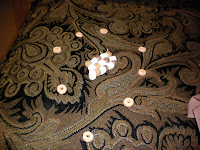Activity 2: Atom and Atomic Structure
For this activity review the Content Slides (Atoms and Atomic Structure) and complete the activities/questions below.
Make a model of your three favorite elements on the Periodic Chart. The models must be 3-dimensional and be made out of common objects around your home. Place photos of your three models with descriptions on your blog. Your models must include the appropriate number and positioning of protons, neutrons and electrons.
Questions:
1. What is the atomic number for each of your models?
Carbon:6 Oxygen:8 Neon: 10
2. What is the atomic mass number for each of your models?
Carbon: 12.01 Oxygen: 16.00 Neon: 20.18
3. In your models, which two subatomic particles are equal in number?
In my models all of the separate parts are equal.
4. How would you make an isotope for one of your models? What would change with the model?
5. Considering the overall volume of your element models, what makes up most of the volume of an atom? The neutrons and protons that make up the center of the atom that is called the nucleus.
6. For one of your models, show with another image what happens when energy excites an electron.
7. Once the electron is excited, what do we typically observe when the electron returns to the ground-state? http://www.ccmr.cornell.edu/education/ask/index.html?quid=257
8. Why are some elements different colors when they are excited? http://en.wikipedia.org/wiki/Emission_spectrum
9. Do a little research to list which elements are used to make the different colors of fireworks. http://chemistry.about.com/od/howthingswork/How_Things_Work.htm
10. Explain the overall organizational structure of the periodic table.
11. List two example elements for each of these groups or classes: Alkali Metals, Alkaline Earth, Halogens, Noble Gases, Transition Metals, Non-Metals, and Metalloids.
Alkali Metals: Lithium and sodium
Alkaline Earth Metals: Beryllium and Magnesium
Halogens: Fluorine and Chlorine
Noble gases: Helium and Neon
Transition Metals: Scandium and Yttrium
Non-Metals: Carbon an Oxygen
Metalloids: Boron and Silicon
Alkaline Earth Metals: Beryllium and Magnesium
Halogens: Fluorine and Chlorine
Noble gases: Helium and Neon
Transition Metals: Scandium and Yttrium
Non-Metals: Carbon an Oxygen
Metalloids: Boron and Silicon




No comments:
Post a Comment